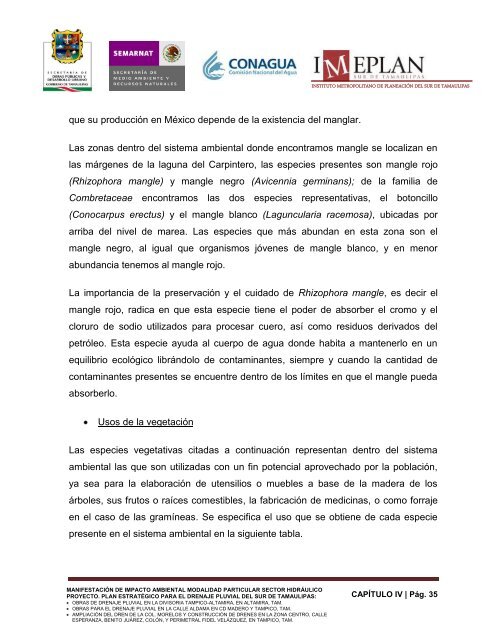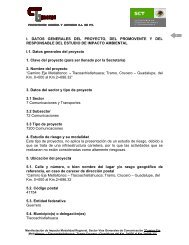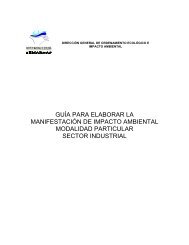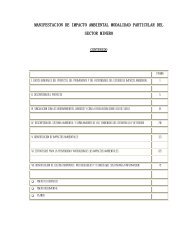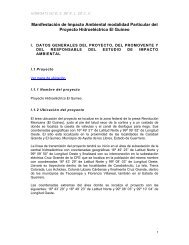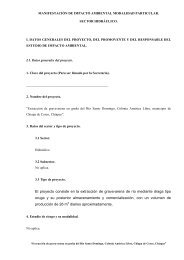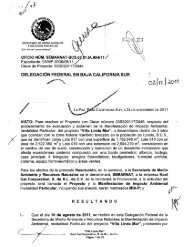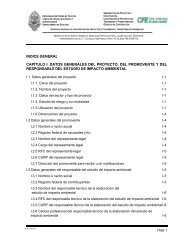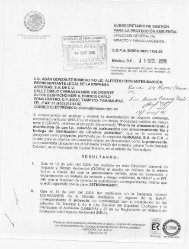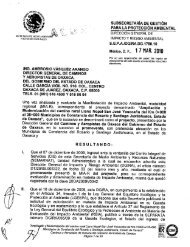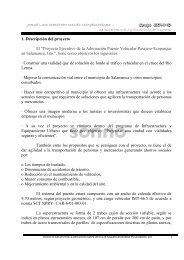plan estratégico para el drenaje pluvial del sur de ... - sinat - Semarnat
plan estratégico para el drenaje pluvial del sur de ... - sinat - Semarnat
plan estratégico para el drenaje pluvial del sur de ... - sinat - Semarnat
Create successful ePaper yourself
Turn your PDF publications into a flip-book with our unique Google optimized e-Paper software.
que su producción en México <strong>de</strong>pen<strong>de</strong> <strong>de</strong> la existencia d<strong>el</strong> manglar.<br />
MANIFESTACIÓN DE IMPACTO AMBIENTAL MODALIDAD PARTICULAR SECTOR HIDRÁULICO<br />
PROYECTO. PLAN ESTRATÉGICO PARA EL DRENAJE PLUVIAL DEL SUR DE TAMAULIPAS:<br />
OBRAS DE DRENAJE PLUVIAL EN LA DIVISORIA TAMPICO-ALTAMIRA, EN ALTAMIRA, TAM.<br />
OBRAS PARA EL DRENAJE PLUVIAL EN LA CALLE ALDAMA EN CD MADERO Y TAMPICO, TAM.<br />
AMPLIACIÓN DEL DREN DE LA COL. MORELOS Y CONSTRUCCIÓN DE DRENES EN LA ZONA CENTRO, CALLE<br />
ESPERANZA, BENITO JUÁREZ, COLÓN, Y PERIMETRAL FIDEL VELÁZQUEZ, EN TAMPICO, TAM.<br />
INSTITUTO METROPOLITANO DE PLANEACIÓN DEL SUR DE TAMAULIPAS<br />
Las zonas <strong>de</strong>ntro d<strong>el</strong> sistema ambiental don<strong>de</strong> encontramos mangle se localizan en<br />
las márgenes <strong>de</strong> la laguna d<strong>el</strong> Carpintero, las especies presentes son mangle rojo<br />
(Rhizophora mangle) y mangle negro (Avicennia germinans); <strong>de</strong> la familia <strong>de</strong><br />
Combretaceae encontramos las dos especies representativas, <strong>el</strong> botoncillo<br />
(Conocarpus erectus) y <strong>el</strong> mangle blanco (Laguncularia racemosa), ubicadas por<br />
arriba d<strong>el</strong> niv<strong>el</strong> <strong>de</strong> marea. Las especies que más abundan en esta zona son <strong>el</strong><br />
mangle negro, al igual que organismos jóvenes <strong>de</strong> mangle blanco, y en menor<br />
abundancia tenemos al mangle rojo.<br />
La importancia <strong>de</strong> la preservación y <strong>el</strong> cuidado <strong>de</strong> Rhizophora mangle, es <strong>de</strong>cir <strong>el</strong><br />
mangle rojo, radica en que esta especie tiene <strong>el</strong> po<strong>de</strong>r <strong>de</strong> absorber <strong>el</strong> cromo y <strong>el</strong><br />
cloruro <strong>de</strong> sodio utilizados <strong>para</strong> procesar cuero, así como residuos <strong>de</strong>rivados d<strong>el</strong><br />
petróleo. Esta especie ayuda al cuerpo <strong>de</strong> agua don<strong>de</strong> habita a mantenerlo en un<br />
equilibrio ecológico librándolo <strong>de</strong> contaminantes, siempre y cuando la cantidad <strong>de</strong><br />
contaminantes presentes se encuentre <strong>de</strong>ntro <strong>de</strong> los límites en que <strong>el</strong> mangle pueda<br />
absorberlo.<br />
Usos <strong>de</strong> la vegetación<br />
Las especies vegetativas citadas a continuación representan <strong>de</strong>ntro d<strong>el</strong> sistema<br />
ambiental las que son utilizadas con un fin potencial aprovechado por la población,<br />
ya sea <strong>para</strong> la <strong>el</strong>aboración <strong>de</strong> utensilios o muebles a base <strong>de</strong> la ma<strong>de</strong>ra <strong>de</strong> los<br />
árboles, sus frutos o raíces comestibles, la fabricación <strong>de</strong> medicinas, o como forraje<br />
en <strong>el</strong> caso <strong>de</strong> las gramíneas. Se especifica <strong>el</strong> uso que se obtiene <strong>de</strong> cada especie<br />
presente en <strong>el</strong> sistema ambiental en la siguiente tabla.<br />
CAPÍTULO IV | Pág. 35


